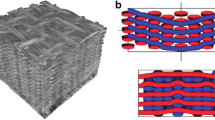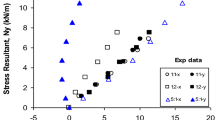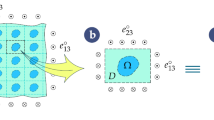Abstract
In this paper, we propose to use a second gradient, 3D orthotropic model for the characterization of the mechanical behavior of thick woven composite interlocks. Such second-gradient theory is seen to directly account for the out-of-plane bending rigidity of the yarns at the mesoscopic scale which is, in turn, related to the bending stiffness of the fibers composing the yarns themselves. The yarns’ bending rigidity evidently affects the macroscopic bending of the material and this fact is revealed by presenting a three-point bending test on \({0 ^{\circ}/90 ^{\circ} \,\,{\rm and}\,\, \pm45 ^{\circ}}\) specimens of composite interlocks. These specimens differ one from the other for the different relative direction of the yarns with respect to the edges of the sample itself. Both types of specimens are independently seen to take advantage of a second-gradient modeling for the correct description of their macroscopic bending modes. The results presented in this paper are essential for the setting up of a correct continuum framework suitable for the mechanical characterization of composite interlocks. The few second-gradient parameters introduced by the present model are all seen to be associated with peculiar deformation modes of the mesostructure (bending of the yarns) and are determined by inverse approach. Although the presented results undoubtedly represent an important step toward the complete characterization of the mechanical behavior of fibrous composite reinforcements, more complex hyperelastic second-gradient constitutive laws must be conceived in order to account for the description of all possible mesostructure-induced deformation patterns.
Similar content being viewed by others
References
Piola G.: The Complete Works of Gabrio Piola: Volume I Commented English Translation (Vol. 38). Springer, Berlin (2014)
Dell’Isola, F., Andreaus, U., Placidi, L.: At the origins and in the vanguard of peridynamics, non-local and higher-gradient continuum mechanics: an underestimated and still topical contribution of Gabrio Piola. Math. Mech. Solids (2014). doi:10.1177/1081286513509811
Mindlin R.D., Eshel N.N.: On first strain-gradient theories in linear elasticity. Int. J. Solids Struct. 4(1), 109–124 (1968)
Mindlin R.D.: Second gradient of strain and surface-tension in linear elasticity. Int. J. Solids Struct. 1(4), 417–438 (1965)
Toupin R.A.: Elastic materials with couple-stresses. Arch. Ration. Mech. Anal. 11(1), 385–414 (1962)
Toupin R.A.: Theories of elasticity with couple-stress. Arch. Ration. Mech. Anal. 17(2), 85–112 (1964)
Mindlin R.D.: Micro-structure in linear elasticity. Arch. Ration. Mech. Anal. 16(1), 51–78 (1964)
Eringen A.C.: Microcontinuum Field Theories I: Foundations and Solids. Springer, Berlin (1999)
Bleustein J.L.: A note on the boundary conditions of Toupin’s strain-gradient theory. Int. J. Solids Struct. 3(6), 1053–1057 (1967)
Neff, P., Ghiba, I.D., Madeo, A., Placidi, L., Rosi, G.: A unifying perspective: the relaxed linear micromorphic continuum. Contin. Mech. Thermodyn. 1–43 (2013)
Madeo, A., Neff, P., Ghiba, I.D., Placidi, L., Rosi, G.: Wave propagation in relaxed micromorphic continua: modeling metamaterials with frequency band-gaps. Contin. Mech. Thermodyn. 1–20 (2013)
Neff P., Forest S.: A geometrically exact micromorphic model for elastic metallic foams accounting for affine microstructure. Modelling, existence of minimizers, identification of moduli and computational results. J. Elast. 87(2–3), 239–276 (2007)
Neff P., Jeong J., Münch I., Ramézani H.: Mean field modeling of isotropic random Cauchy elasticity versus microstretch elasticity. Zeitschrift für angewandte Mathematik und Physik 60(3), 479–497 (2009)
Neff P., Jeong J., Ramézani H.: Subgrid interaction and micro-randomness–Novel invariance requirements in infinitesimal gradient elasticity. Int. J. Solids Struct. 46(25), 4261–4276 (2009)
Cosserat, E., Cosserat, F.: Théorie des Corps déformables. Paris (1909)
Germain P.: La méthode des puissances virtuelles en mécanique des milieux continus-I: théorie du second gradient. J. Mécanique 12, 235–274 (1973)
Germain P.: The method of virtual power in continuum mechanics. Part 2: microstructure. SIAM J. Appl. Math. 25(3), 556–575 (1973)
Ferretti M., Madeo A., dell’Isola F., Boisse P.: Modeling the onset of shear boundary layers in fibrous composite reinforcements by second-gradient theory. Zeitschrift für angewandte Mathematik und Physik 65, 587–612 (2013)
Forest, S.: Mechanics of generalized continua: construction by homogenizaton. Le J. de Physique IV 8, Pr8-39-48 (1998)
Kruch, S., Forest, S.: Computation of coarse grain structures using a homogeneous equivalent medium. Le J. de Physique IV 8, Pr8-197–205 (1998)
Forest, S.: Homogenization methods and mechanics of generalized continua-part 2. Theor. Appl. Mech. (28–29), 113–144 (2002)
Forest, S.: Homogenization methods and the mechanics of generalized continua. In: Maugin, G. (ed.) Geometry, Continua and Microstructure, Travaux en Cours No. 60, pp. 35–48. Hermann, Paris, France (1999)
Askes H., Aifantis E.C.: Gradient elasticity in statics and dynamics: an overview of formulations, length scale identification procedures, finite element implementations and new results. Int. J. Solids Struct. 48(13), 1962–1990 (2011)
Exadaktylos G.E., Vardoulakis I.: Microstructure in linear elasticity and scale effects: a reconsideration of basic rock mechanics and rock fracture mechanics. Tectonophysics 335(1), 81–109 (2001)
Eremeyev V.A., Pietraszkiewicz W.: Material symmetry group of the non-linear polar-elastic continuum. Int. J. Solids Struct. 49(14), 1993–2005 (2012)
Altenbach H., Eremeyev V.A., Lebedev L.P., Rendon L.A.: Acceleration waves and ellipticity in thermoelastic micropolar media. Arch. Appl. Mech. 80(3), 217–227 (2010)
Eremeyev V. A., Lebedev L.P., Altenbach H.: Foundations of micropolar mechanics. Springer, Heidelberg (2013)
Piccardo G., Ranzi G., Luongo A.: A complete dynamic approach to the generalized beam theory cross-section analysis including extension and shear modes. Math. Mech. Solids (2013). doi:10.1177/1081286513493107
Yang Y., Misra A.: Micromechanics based second gradient continuum theory for shear band modeling in cohesive granular materials following damage elasticity. Int. J. Solids Struct. 49(18), 2500–2514 (2012)
Engheta N., Ziolkowski R.W.: Metamaterials: Physics and Engineering Explorations. Wiley, New York (2006)
Zouhdi, S., Sihvola, A.H., Vinogradov, A.P. (eds.): Metamaterials and Plasmonics: Fundamentals, Modelling, Applications. Springer, Berlin (2009)
Alibert J.J., Seppecher P., Dell’Isola F.: Truss modular beams with deformation energy depending on higher displacement gradients. Math. Mech. Solids 8(1), 51–73 (2003)
Pideri C., Seppecher P.: A second gradient material resulting from the homogenization of an heterogeneous linear elastic medium. Contin. Mech. Thermodyn. 9(5), 241–257 (1997)
Dumont J.P., Ladeveze P., Poss M., Remond Y.: Damage mechanics for 3-D composites. Compos. Struct. 8(2), 119–141 (1987)
Charmetant A., Orliac J.G., Vidal-Sallé E., Boisse P.: Hyperelastic model for large deformation analyses of 3D interlock composite preforms. Compos. Sci. Technol. 72(12), 1352–1360 (2012)
dell’Isola, F., Steigmann, D.: A two-dimensional gradient-elasticity theory for woven fabrics. J. Elast. 1–13 (2014)
Spencer A.J.M., Soldatos K.P.: Finite deformations of fibre-reinforced elastic solids with fibre bending stiffness. Int. J. Non-Linear Mech. 42(2), 355–368 (2007)
Luongo A.: On the amplitude modulation and localization phenomena in interactive buckling problems. Int. J. Solids Struct. 27(15), 1943–1954 (1991)
Luongo A.: Mode localization in dynamics and buckling of linear imperfect continuous structures. Nonlinear Dyn. 25(1–3), 133–156 (2001)
Luongo A., Di Egidio A.: Bifurcation equations through multiple-scales analysis for a continuous model of a planar beam. Nonlinear Dyn. 41(1–3), 171–190 (2005)
Seppecher P., Alibert J.J., dell’Isola F.: Linear elastic trusses leading to continua with exotic mechanical interactions. J. Phys.: Conf. Ser. 319:1, 012018 (2011)
Boutin C., Hans S.: Homogenisation of periodic discrete medium: application to dynamics of framed structures. Comput. Geotech. 30(4), 303–320 (2003)
Ghazavizadeh A., Rutledge G.C., Atai A.A., Ahzi S., Rémond Y., Soltani N.: Micromechanical characterization of the interphase layer in semi-crystalline polyethylene. J. Polym. Sci. Part B: Polym. Phys. 51(16), 1228–1243 (2013)
Michel J.C., Moulinec H., Suquet P.: Effective properties of composite materials with periodic microstructure: a computational approach. Comput. Methods Appl. Mech. Eng. 172(1), 109–143 (1999)
Moulinec H., Suquet P.: Comparison of FFT-based methods for computing the response of composites with highly contrasted mechanical properties. Phys. B: Condens. Matter 338(1), 58–60 (2003)
Sanchez-Palencia, E.: Homogenization method for the study of composite media. In: Asymptotic Analysis II, pp. 192–214. Springer, Berlin (1983)
Oshmyan V.G., Patlazhan S.A., Remond Y.: Principles of structural–mechanical modeling of polymers and composites. Polym. Sci. Ser. A 48(9), 1004–1013 (2006)
Dagli L., Remond Y.: Identification of the non-linear behaviour a 4D carbon–carbon material designed for aeronautic application. Appl. Compos. Mater. 9(1), 1–15 (2002)
Mikdam A., Makradi A., Ahzi S., Garmestani H., Li D.S., Remond Y.: Statistical continuum theory for the effective conductivity of fiber filled polymer composites: effect of orientation distribution and aspect ratio. Compos. Sci. Technol. 70(3), 510–517 (2010)
Raoult A.: Symmetry groups in nonlinear elasticity: an exercise in vintage mathematics. Commun. Pure Appl. Anal. 8(1), 435–456 (2009)
Schröder J., Neff P.: Invariant formulation of hyperelastic transverse isotropy based on polyconvex free energy functions. Int. J. Solids Struct. 40(2), 401–445 (2003)
Balzani D., Neff P., Schröder J., Holzapfel G.A.: A polyconvex framework for soft biological tissues. Adjustment to experimental data. Int. J. Solids Struct. 43(20), 6052–6070 (2006)
Schröder J., Neff P., Ebbing V.: Anisotropic polyconvex energies on the basis of crystallographic motivated structural tensors. J. Mech. Phys. Solids 56(12), 3486–3506 (2008)
Andreaus U., Chiaia B., Placidi L.: Soft-impact dynamics of deformable bodies. Continuum Mech. Thermodyn. 25(2–4), 375–398 (2013)
Cuomo M., Ventura G.: Complementary energy approach to contact problems based on consistent augmented Lagrangian formulation. Math. Comput. Model. 28(4–8), 185–204 (1998)
Turco E.: A strategy to identify exciting forces acting on structures. Int. J. Numer. Methods Eng 64(11), 1483–1508 (2005)
Orliac, J.G.: Analyse et simulation du comportement anisotrope lors de la mise en forme de renforts tissés interlock. Ph.D. thesis, INSA-Lyon (2012)
Ghiba, I.D., Bulgariu, E.: On spatial evolution of the solution of a non-standard problem in the bending theory of elastic plates. IMA J. Appl. Math. (2013). doi:10.1093/imamat/hxt046
Ghiba I.D.: Semi-inverse solution for Saint-Venant’s problem in the theory of porous elastic materials. Eur. J. Mech.-A/Solids 27(6), 1060–1074 (2008)
Bulgariu E., Ghiba I.D.: On the thermal stresses in anisotropic porous cylinders. Discret. Contin. Dyn. Syst. Ser. S 6, 1539–1550 (2013)
Charmetant, A.: Approches hyperélastiques pour la modélisation du comportement mécanique de préformes tissées de composites. Ph.D. thesis, INSA-Lyon (2011)
Author information
Authors and Affiliations
Corresponding author
Additional information
The authors thank INSA-Lyon for the financial support assigned to the project BQR 2013-0054 “Matériaux Méso et Micro-Hétérogènes: Optimisation par Modèles de Second Gradient et Applications en Ingénierie”. The second author thanks the Rhône-Alpes Région for partial funding of this project. The first and the last authors thank CRNS-INSIS for support to the PEPS project “Modélisation en Second Gradient des Renforts Fibreux de Composites”.
Rights and permissions
About this article
Cite this article
Madeo, A., Ferretti, M., dell’Isola, F. et al. Thick fibrous composite reinforcements behave as special second-gradient materials: three-point bending of 3D interlocks. Z. Angew. Math. Phys. 66, 2041–2060 (2015). https://doi.org/10.1007/s00033-015-0496-z
Received:
Revised:
Published:
Issue Date:
DOI: https://doi.org/10.1007/s00033-015-0496-z




